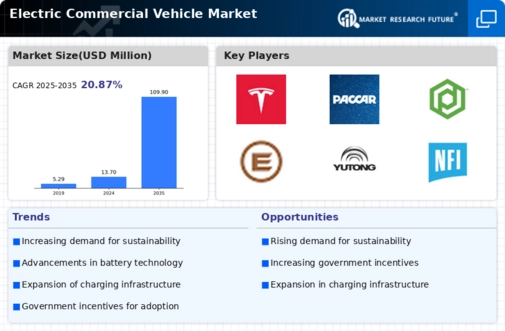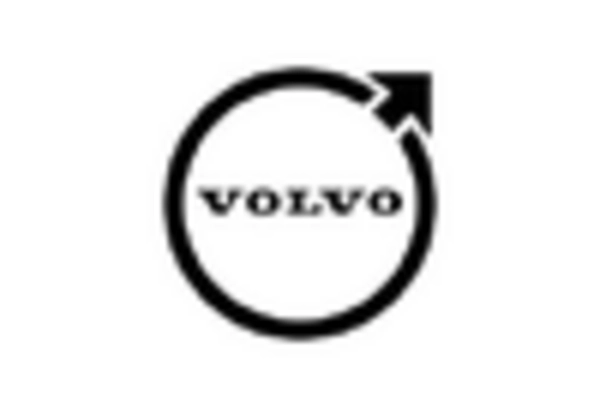-
EXECUTIVE SUMMARY 15
-
GLOBAL ELECTRIC COMMERCIAL VEHICLE MARKET, BY PROPULSION 17
-
GLOBAL ELECTRIC COMMERCIAL VEHICLE MARKET, BY COMPONENT 18
-
GLOBAL ELECTRIC COMMERCIAL VEHICLE MARKET, BY VEHICLE TYPE 19
-
GLOBAL ELECTRIC COMMERCIAL VEHICLE MARKET, BY REGION 20
-
MARKET INTRODUCTION 21
-
DEFINITION 21
-
SCOPE OF THE STUDY 21
-
RESEARCH OBJECTIVE 21
-
MARKET STRUCTURE 22
-
RESEARCH METHODOLOGY 23
-
RESEARCH PROCESS 23
-
PRIMARY RESEARCH 24
-
SECONDARY RESEARCH 25
-
MARKET SIZE ESTIMATION 26
-
FORECAST MODEL 27
-
LIST OF ASSUMPTIONS 28
-
MARKET DYNAMICS 29
-
INTRODUCTION 29
-
DRIVERS 30
- GOVERNMENT INITIATIVES TO ENCOURAGE ADOPTION OF ELECTRIC COMMERCIAL VEHICLES 30
- LOW OPERATING COST 30
- DRIVERS IMPACT ANALYSIS 31
-
RESTRAINTS 31
- UNDERDEVELOPED CHARGING INFRASTRUCTURE AND POOR AFTERMARKET SERVICES 31
- HIGH PRICE AND LIMITED CAPACITY OF BATTERIES 32
- RESTRAINT IMPACT ANALYSIS 32
-
OPPORTUNITIES 33
- INCREASING LOGISTIC ACTIVITIES 33
- GROWTH IN DEMAND WITHIN FLEETS 33
-
COVID 19 IMPACT ANALYSIS 34
- ECONOMIC IMPACT ON AUTOMOTIVE INDUSTRY 34
- IMPACT ON AUTOMOTIVE PRODUCTION 34
- IMPACT ON ELECTRIC COMMERCIAL VEHICLE MARKET 36
- IMPACT ON WORLD TRADE 36
-
MARKET FACTOR ANALYSIS 37
-
SUPPLY CHAIN ANALYSIS: GLOBAL ELECTRIC COMMERCIAL VEHICLE MARKET 37
- DESIGN AND DEVELOPMENT 37
- RAW MATERIAL SUPPLY 38
- ASSEMBLY 38
- DISTRIBUTION 38
- END USER 38
-
PORTER'S FIVE FORCES MODEL 39
- THREAT OF NEW ENTRANTS 39
- BARGAINING POWER OF SUPPLIERS 40
- THREAT OF SUBSTITUTES 40
- BARGAINING POWER OF BUYERS 40
- INTENSITY OF RIVALRY 40
-
GLOBAL ELECTRIC COMMERCIAL VEHICLE MARKET, BY PROPULSION 41
-
OVERVIEW 41
-
BEV 42
-
PHEV 42
-
FCEV 43
-
GLOBAL ELECTRIC COMMERCIAL VEHICLE MARKET, BY COMPONENT 44
-
OVERVIEW 44
-
ELECTRIC MOTOR 45
-
ELECTRIC VEHICLE BATTERY 45
-
HYDROGEN FUEL CELL 46
-
OTHERS 46
-
GLOBAL ELECTRIC COMMERCIAL VEHICLE MARKET, BY VEHICLE TYPE 47
-
OVERVIEW 47
-
BUS 48
-
TRUCK 48
-
OTHERS 49
-
GLOBAL ELECTRIC COMMERCIAL VEHICLE MARKET, BY REGION 50
-
OVERVIEW 50
-
NORTH AMERICA 52
- US 54
- CANADA 55
- MEXICO 56
-
EUROPE 57
- GERMANY 59
- UK 60
- FRANCE 61
- ITALY 62
- REST OF EUROPE 63
-
ASIA-PACIFIC 65
- CHINA 67
- JAPAN 68
- INDIA 69
- REST OF ASIA-PACIFIC 70
-
REST OF WORLD 72
- MIDDLE EAST & AFRICA 74
- SOUTH AMERICA 75
-
COMPETITIVE LANDSCAPE 76
-
COMPETITIVE OVERVIEW 76
-
COMPETITIVE BENCHMARKING 77
-
MARKET SHARE ANALYSIS 78
-
KEY DEVELOPMENTS IN THE GLOBAL ELECTRIC COMMERCIAL VEHICLE MARKET 78
- KEY DEVELOPMENTS: CONTRACTS & AGREEMENTS 78
- KEY DEVELOPMENTS: PARTNERSHIPS & COLLABORATIONS 80
- KEY DEVELOPMENTS: EXPANSIONS 80
- KEY DEVELOPMENTS: PRODUCT DEVELOPMENTS/LAUNCHES 81
- KEY DEVELOPMENTS: 82
-
COMPANY PROFILE 83
-
AB VOLVO 83
- COMPANY OVERVIEW 83
- FINANCIAL OVERVIEW 84
- PRODUCTS OFFERED 85
- KEY DEVELOPMENTS 85
- SWOT ANALYSIS 86
- KEY STRATEGIES 86
-
TESLA INC 87
- COMPANY OVERVIEW 87
- FINANCIAL OVERVIEW 88
- PRODUCTS OFFERED 88
- KEY DEVELOPMENTS 89
- SWOT ANALYSIS 89
- KEY STRATEGIES 90
-
DAIMLER TRUCK AG 91
- COMPANY OVERVIEW 91
- FINANCIAL OVERVIEW 92
- PRODUCTS OFFERED 92
- KEY DEVELOPMENTS 93
- SWOT ANALYSIS 94
- KEY STRATEGIES 94
-
PACCAR INC. 95
- COMPANY OVERVIEW 95
- FINANCIAL OVERVIEW 96
- PRODUCTS OFFERED 97
- KEY DEVELOPMENTS 97
- SWOT ANALYSIS 98
- KEY STRATEGIES 98
-
BYD COMPANY LIMITED 99
- COMPANY OVERVIEW 99
- FINANCIAL OVERVIEW 100
- PRODUCTS OFFERED 100
- KEY DEVELOPMENTS 101
- SWOT ANALYSIS 102
- KEY STRATEGIES 102
-
PROTERRA 103
- COMPANY OVERVIEW 103
- FINANCIAL OVERVIEW 104
- PRODUCTS OFFERED 104
- KEY DEVELOPMENTS 105
- SWOT ANALYSIS 106
- KEY STRATEGIES 106
-
-
EBUSCO 107
- COMPANY OVERVIEW 107
- FINANCIAL OVERVIEW 108
- PRODUCTS OFFERED 108
- KEY DEVELOPMENTS 109
- SWOT ANALYSIS 109
- KEY STRATEGIES 109
-
ANHUI ANKAI AUTOMOBILE CO., LTD 111
- COMPANY OVERVIEW 111
- FINANCIAL OVERVIEW 111
- PRODUCTS OFFERED 112
- KEY DEVELOPMENTS 112
- SWOT ANALYSIS 113
- KEY STRATEGIES 113
-
YUTONG 114
- COMPANY OVERVIEW 114
- FINANCIAL OVERVIEW 114
- PRODUCTS OFFERED 115
- KEY DEVELOPMENTS 115
- SWOT ANALYSIS 116
- KEY STRATEGIES 116
-
NFI GROUP INC. 117
- COMPANY OVERVIEW 117
- FINANCIAL OVERVIEW 118
- PRODUCTS OFFERED 119
- KEY DEVELOPMENTS 119
- SWOT ANALYSIS 120
- KEY STRATEGIES 120
-
SCANIA 121
- COMPANY OVERVIEW 121
- FINANCIAL OVERVIEW 122
- PRODUCTS OFFERED 122
- KEY DEVELOPMENTS 123
-
VDL 124
- COMPANY OVERVIEW 124
- FINANCIAL OVERVIEW 125
- PRODUCTS OFFERED 125
- KEY DEVELOPMENTS 126
-
CAF 127
- COMPANY OVERVIEW 127
- FINANCIAL OVERVIEW 128
- PRODUCTS OFFERED 128
- KEY DEVELOPMENTS 129
-
KING LONG 130
- COMPANY OVERVIEW 130
- FINANCIAL OVERVIEW 130
- PRODUCTS OFFERED 130
- KEY DEVELOPMENTS 131
-
RENAULT TRUCKS 132
- COMPANY OVERVIEW 132
- FINANCIAL OVERVIEW 132
- PRODUCTS OFFERED 132
- KEY DEVELOPMENTS 133
-
-
LIST OF TABLES
-
LIST OF ASSUMPTIONS 28
-
GLOBAL ELECTRIC COMMERCIAL VEHICLE MARKET ESTIMATES & FORECAST, BY PROPULSION, 2018-2030 (USD MILLION) 42
-
GLOBAL ELECTRIC COMMERCIAL VEHICLE MARKET ESTIMATES & FORECAST, BY COMPONENT, 2018-2030 (USD MILLION) 45
-
GLOBAL ELECTRIC COMMERCIAL VEHICLE MARKET ESTIMATES & FORECAST, BY VEHICLE TYPE, 2018-2030 (USD MILLION) 48
-
GLOBAL ELECTRIC COMMERCIAL VEHICLE MARKET SIZE, BY REGION, 2018-2030 (USD MILLION) 51
-
NORTH AMERICA: ELECTRIC COMMERCIAL VEHICLE MARKET SIZE, BY COUNTRY, 2018-2030 (USD MILLION) 52
-
NORTH AMERICA ELECTRIC COMMERCIAL VEHICLE MARKET ESTIMATES & FORECAST, BY PROPULSION,
-
NORTH AMERICA ELECTRIC COMMERCIAL VEHICLE MARKET ESTIMATES & FORECAST, BY COMPONENT,
-
NORTH AMERICA ELECTRIC COMMERCIAL VEHICLE MARKET ESTIMATES & FORECAST, BY VEHICLE TYPE,
-
US ELECTRIC COMMERCIAL VEHICLE MARKET ESTIMATES & FORECAST, BY PROPULSION, 2018-2030 (USD MILLION) 54
-
US ELECTRIC COMMERCIAL VEHICLE MARKET ESTIMATES & FORECAST, BY COMPONENT, 2018-2030 (USD MILLION) 54
-
US ELECTRIC COMMERCIAL VEHICLE MARKET ESTIMATES & FORECAST, BY VEHICLE TYPE, 2018-2030 (USD MILLION) 54
-
CANADA ELECTRIC COMMERCIAL VEHICLE MARKET ESTIMATES & FORECAST, BY PROPULSION, 2018-2030 (USD MILLION) 55
-
CANADA ELECTRIC COMMERCIAL VEHICLE MARKET ESTIMATES & FORECAST, BY COMPONENT, 2018-2030 (USD MILLION) 55
-
CANADA ELECTRIC COMMERCIAL VEHICLE MARKET ESTIMATES & FORECAST, BY VEHICLE TYPE, 2018-2030 (USD MILLION) 55
-
MEXICO ELECTRIC COMMERCIAL VEHICLE MARKET ESTIMATES & FORECAST, BY PROPULSION, 2018-2030 (USD MILLION) 56
-
MEXICO ELECTRIC COMMERCIAL VEHICLE MARKET ESTIMATES & FORECAST, BY COMPONENT, 2018-2030 (USD MILLION) 56
-
MEXICO ELECTRIC COMMERCIAL VEHICLE MARKET ESTIMATES & FORECAST, BY VEHICLE TYPE, 2018-2030 (USD MILLION) 56
-
EUROPE: ELECTRIC COMMERCIAL VEHICLE MARKET SIZE, BY COUNTRY, 2018-2030 (USD MILLION) 58
-
EUROPE ELECTRIC COMMERCIAL VEHICLE MARKET ESTIMATES & FORECAST, BY PROPULSION, 2018-2030 (USD MILLION) 58
-
EUROPE ELECTRIC COMMERCIAL VEHICLE MARKET ESTIMATES & FORECAST, BY COMPONENT, 2018-2030 (USD MILLION) 58
-
EUROPE ELECTRIC COMMERCIAL VEHICLE MARKET ESTIMATES & FORECAST, BY VEHICLE TYPE, 2018-2030 (USD MILLION) 59
-
GERMANY ELECTRIC COMMERCIAL VEHICLE MARKET ESTIMATES & FORECAST, BY PROPULSION, 2018-2030 (USD MILLION) 59
-
GERMANY ELECTRIC COMMERCIAL VEHICLE MARKET ESTIMATES & FORECAST, BY COMPONENT, 2018-2030 (USD MILLION) 59
-
GERMANY ELECTRIC COMMERCIAL VEHICLE MARKET ESTIMATES & FORECAST, BY VEHICLE TYPE, 2018-2030 (USD MILLION) 60
-
UK ELECTRIC COMMERCIAL VEHICLE MARKET ESTIMATES & FORECAST, BY PROPULSION, 2018-2030 (USD MILLION) 60
-
UK ELECTRIC COMMERCIAL VEHICLE MARKET ESTIMATES & FORECAST, BY COMPONENT, 2018-2030 (USD MILLION) 60
-
UK ELECTRIC COMMERCIAL VEHICLE MARKET ESTIMATES & FORECAST, BY VEHICLE TYPE, 2018-2030 (USD MILLION) 61
-
FRANCE ELECTRIC COMMERCIAL VEHICLE MARKET ESTIMATES & FORECAST, BY PROPULSION, 2018-2030 (USD MILLION) 61
-
FRANCE ELECTRIC COMMERCIAL VEHICLE MARKET ESTIMATES & FORECAST, BY COMPONENT, 2018-2030 (USD MILLION) 61
-
FRANCE ELECTRIC COMMERCIAL VEHICLE MARKET ESTIMATES & FORECAST, BY VEHICLE TYPE, 2018-2030 (USD MILLION) 62
-
ITALY ELECTRIC COMMERCIAL VEHICLE MARKET ESTIMATES & FORECAST, BY PROPULSION, 2018-2030 (USD MILLION) 62
-
ITALY ELECTRIC COMMERCIAL VEHICLE MARKET ESTIMATES & FORECAST, BY COMPONENT, 2018-2030 (USD MILLION) 62
-
ITALY ELECTRIC COMMERCIAL VEHICLE MARKET ESTIMATES & FORECAST, BY VEHICLE TYPE, 2018-2030 (USD MILLION) 63
-
REST OF EUROPE ELECTRIC COMMERCIAL VEHICLE MARKET ESTIMATES & FORECAST, BY PROPULSION,
-
REST OF EUROPE ELECTRIC COMMERCIAL VEHICLE MARKET ESTIMATES & FORECAST, BY COMPONENT,
-
REST OF EUROPE ELECTRIC COMMERCIAL VEHICLE MARKET ESTIMATES & FORECAST, BY VEHICLE TYPE,
-
ASIA-PACIFIC: ELECTRIC COMMERCIAL VEHICLE MARKET SIZE, BY COUNTRY, 2018-2030 (USD MILLION) 66
-
ASIA-PACIFIC ELECTRIC COMMERCIAL VEHICLE MARKET ESTIMATES & FORECAST, BY PROPULSION, 2018-2030 (USD MILLION) 66
-
ASIA-PACIFIC ELECTRIC COMMERCIAL VEHICLE MARKET ESTIMATES & FORECAST, BY COMPONENT, 2018-2030 (USD MILLION) 66
-
ASIA-PACIFIC ELECTRIC COMMERCIAL VEHICLE MARKET ESTIMATES & FORECAST, BY VEHICLE TYPE, 2018-2030 (USD MILLION) 67
-
CHINA ELECTRIC COMMERCIAL VEHICLE MARKET ESTIMATES & FORECAST, BY PROPULSION, 2018-2030 (USD MILLION) 67
-
CHINA ELECTRIC COMMERCIAL VEHICLE MARKET ESTIMATES & FORECAST, BY COMPONENT, 2018-2030 (USD MILLION) 67
-
CHINA ELECTRIC COMMERCIAL VEHICLE MARKET ESTIMATES & FORECAST, BY VEHICLE TYPE, 2018-2030 (USD MILLION) 68
-
JAPAN ELECTRIC COMMERCIAL VEHICLE MARKET ESTIMATES & FORECAST, BY PROPULSION, 2018-2030 (USD MILLION) 68
-
JAPAN ELECTRIC COMMERCIAL VEHICLE MARKET ESTIMATES & FORECAST, BY COMPONENT, 2018-2030 (USD MILLION) 68
-
JAPAN ELECTRIC COMMERCIAL VEHICLE MARKET ESTIMATES & FORECAST, BY VEHICLE TYPE, 2018-2030 (USD MILLION) 69
-
INDIA ELECTRIC COMMERCIAL VEHICLE MARKET ESTIMATES & FORECAST, BY PROPULSION, 2018-2030 (USD MILLION) 69
-
INDIA ELECTRIC COMMERCIAL VEHICLE MARKET ESTIMATES & FORECAST, BY COMPONENT, 2018-2030 (USD MILLION) 69
-
INDIA ELECTRIC COMMERCIAL VEHICLE MARKET ESTIMATES & FORECAST, BY VEHICLE TYPE, 2018-2030 (USD MILLION) 70
-
REST OF ASIA-PACIFIC ELECTRIC COMMERCIAL VEHICLE MARKET ESTIMATES & FORECAST, BY PROPULSION,
-
REST OF ASIA-PACIFIC ELECTRIC COMMERCIAL VEHICLE MARKET ESTIMATES & FORECAST, BY COMPONENT,
-
REST OF ASIA-PACIFIC ELECTRIC COMMERCIAL VEHICLE MARKET ESTIMATES & FORECAST, BY VEHICLE TYPE,
-
REST OF WORLD: ELECTRIC COMMERCIAL VEHICLE MARKET SIZE, BY REGION, 2018-2030 (USD MILLION) 72
-
REST OF WORLD ELECTRIC COMMERCIAL VEHICLE MARKET ESTIMATES & FORECAST, BY PROPULSION,
-
REST OF WORLD ELECTRIC COMMERCIAL VEHICLE MARKET ESTIMATES & FORECAST, BY COMPONENT,
-
REST OF WORLD ELECTRIC COMMERCIAL VEHICLE MARKET ESTIMATES & FORECAST, BY VEHICLE TYPE,
-
MIDDLE EAST & AFRICA ELECTRIC COMMERCIAL VEHICLE MARKET ESTIMATES & FORECAST, BY PROPULSION,
-
MIDDLE EAST & AFRICA ELECTRIC COMMERCIAL VEHICLE MARKET ESTIMATES & FORECAST, BY COMPONENT,
-
MIDDLE EAST & AFRICA ELECTRIC COMMERCIAL VEHICLE MARKET ESTIMATES & FORECAST, BY VEHICLE TYPE,
-
SOUTH AMERICA ELECTRIC COMMERCIAL VEHICLE MARKET ESTIMATES & FORECAST, BY PROPULSION,
-
SOUTH AMERICA ELECTRIC COMMERCIAL VEHICLE MARKET ESTIMATES & FORECAST, BY COMPONENT,
-
SOUTH AMERICA ELECTRIC COMMERCIAL VEHICLE MARKET ESTIMATES & FORECAST, BY VEHICLE TYPE,
-
KEY DEVELOPMENTS: CONTRACTS & AGREEMENTS 78
-
KEY DEVELOPMENTS: PARTNERSHIPS & COLLABORATIONS 80
-
KEY DEVELOPMENTS: EXPANSIONS 80
-
KEY DEVELOPMENTS: PRODUCT DEVELOPMENTS/LAUNCHES 81
-
KEY DEVELOPMENTS: ACQUISITION 82
-
AB VOLVO: PRODUCTS OFFERED 85
-
AB VOLVO: KEY DEVELOPMENTS 85
-
TESLA: PRODUCTS OFFERED 88
-
TESLA: KEY DEVELOPMENTS 89
-
DAIMLER TRUCK AG: PRODUCTS OFFERED 92
-
DAIMLER TRUCK AG: KEY DEVELOPMENTS 93
-
PACCAR INC.: PRODUCTS OFFERED 97
-
PACCAR INC.: KEY DEVELOPMENTS 97
-
BYD COMPANY LIMITED: PRODUCTS OFFERED 100
-
BYD COMPANY LIMITED: KEY DEVELOPMENTS 101
-
PROTERRA: PRODUCTS OFFERED 104
-
PROTERRA: KEY DEVELOPMENTS 105
-
EBUSCO: PRODUCTS OFFERED 108
-
EBUSCO: KEY DEVELOPMENTS 109
-
ANHUI ANKAI AUTOMOBILE CO., LTD.: PRODUCTS OFFERED 112
-
ANHUI ANKAI AUTOMOBILE CO., LTD.: KEY DEVELOPMENTS 112
-
YUTONG: PRODUCTS OFFERED 115
-
YUTONG: KEY DEVELOPMENTS 115
-
NFI GROUP INC.: PRODUCTS OFFERED 119
-
NFI GROUP INC.: KEY DEVELOPMENTS 119
-
SCANIA: PRODUCTS OFFERED 122
-
SCANIA: KEY DEVELOPMENTS 123
-
VDL: PRODUCTS OFFERED 125
-
VDL: KEY DEVELOPMENTS 126
-
CAF: PRODUCTS OFFERED 128
-
CAF: KEY DEVELOPMENTS 129
-
KING LONG: PRODUCTS OFFERED 130
-
KING LONG: KEY DEVELOPMENTS 131
-
RENAULT TRUCKS: PRODUCTS OFFERED 132
-
RENAULT TRUCKS: KEY DEVELOPMENTS 133
-
-
LIST OF FIGURES
-
MARKET SYNOPSIS 16
-
GLOBAL ELECTRIC COMMERCIAL VEHICLE MARKET ANALYSIS, BY PROPULSION, 2022 (%) 17
-
GLOBAL ELECTRIC COMMERCIAL VEHICLE MARKET ANALYSIS, BY COMPONENT, 2022 (%) 18
-
GLOBAL ELECTRIC COMMERCIAL VEHICLE MARKET ANALYSIS, BY VEHICLE TYPE, 2022 (%) 19
-
GLOBAL ELECTRIC COMMERCIAL VEHICLE MARKET ANALYSIS, BY REGION, 2022 (%) 20
-
GLOBAL ELECTRIC COMMERCIAL VEHICLE MARKET: STRUCTURE 22
-
RESEARCH PROCESS 23
-
TOP-DOWN & BOTTOM-UP APPROACHES 26
-
MARKET DYNAMICS OVERVIEW 29
-
DRIVERS IMPACT ANALYSIS: GLOBAL ELECTRIC COMMERCIAL VEHICLE MARKET 31
-
RESTRAINT IMPACT ANALYSIS: GLOBAL ELECTRIC COMMERCIAL VEHICLE MARKET 32
-
SUPPLY CHAIN: GLOBAL ELECTRIC COMMERCIAL VEHICLE MARKET 37
-
PORTER'S FIVE FORCES ANALYSIS OF THE ELECTRIC COMMERCIAL VEHICLE MARKET 39
-
GLOBAL ELECTRIC COMMERCIAL VEHICLE MARKET, BY PROPULSION, 2022 (% SHARE) 41
-
GLOBAL ELECTRIC COMMERCIAL VEHICLE MARKET, BY PROPULSION, 2018 TO 2030 (USD MILLION) 41
-
GLOBAL ELECTRIC COMMERCIAL VEHICLE MARKET, BY COMPONENT, 2022 (% SHARE) 44
-
GLOBAL ELECTRIC COMMERCIAL VEHICLE MARKET, BY COMPONENT, 2018 TO 2030 (USD MILLION) 44
-
GLOBAL ELECTRIC COMMERCIAL VEHICLE MARKET, BY VEHICLE TYPE, 2022 (% SHARE) 47
-
GLOBAL ELECTRIC COMMERCIAL VEHICLE MARKET, BY VEHICLE TYPE, 2018 TO 2030 (USD MILLION) 47
-
GLOBAL ELECTRIC COMMERCIAL VEHICLE MARKET, BY REGION, 2022 (% SHARE) 50
-
GLOBAL ELECTRIC COMMERCIAL VEHICLE MARKET, BY REGION, 2018 TO 2030 (USD MILLION) 51
-
NORTH AMERICA: ELECTRIC COMMERCIAL VEHICLE MARKET SHARE, BY COUNTRY, 2022 (% SHARE) 52
-
EUROPE: ELECTRIC COMMERCIAL VEHICLE MARKET SHARE, BY COUNTRY, 2022 (% SHARE) 57
-
ASIA-PACIFIC: ELECTRIC COMMERCIAL VEHICLE MARKET SHARE, BY COUNTRY, 2022 (% SHARE) 65
-
REST OF WORLD: ELECTRIC COMMERCIAL VEHICLE MARKET SHARE, BY REGION, 2022 (% SHARE) 72
-
BENCHMARKING OF MAJOR COMPETITORS 77
-
GLOBAL ELECTRIC COMMERCIAL VEHICLE MARKET SHARE ANALYSIS, 2022 78
-
AB VOLVO: FINANCIAL OVERVIEW SNAPSHOT 84
-
AB VOLVO: SWOT ANALYSIS 86
-
TESLA: FINANCIAL OVERVIEW SNAPSHOT 88
-
TESLA: SWOT ANALYSIS 89
-
DAIMLER TRUCK AG: FINANCIAL OVERVIEW SNAPSHOT 92
-
DAIMLER TRUCK AG: SWOT ANALYSIS 94
-
PACCAR INC.: FINANCIAL OVERVIEW SNAPSHOT 96
-
PACCAR INC.: SWOT ANALYSIS 98
-
BYD COMPANY LIMITED: FINANCIAL OVERVIEW SNAPSHOT 100
-
BYD COMPANY LIMITED: SWOT ANALYSIS 102
-
PROTERRA: FINANCIAL OVERVIEW SNAPSHOT 104
-
PROTERRA: SWOT ANALYSIS 106
-
EBUSCO: FINANCIAL OVERVIEW SNAPSHOT 108
-
EBUSCO: SWOT ANALYSIS 109
-
ANHUI ANKAI AUTOMOBILE CO., LTD.: FINANCIAL OVERVIEW SNAPSHOT 111
-
ANHUI ANKAI AUTOMOBILE CO., LTD.: SWOT ANALYSIS 113
-
YUTONG: FINANCIAL OVERVIEW SNAPSHOT 114
-
YUTONG: SWOT ANALYSIS 116
-
NFI GROUP INC.: FINANCIAL OVERVIEW SNAPSHOT 118
-
NFI GROUP INC: SWOT ANALYSIS 120
-
SCANIA: FINANCIAL OVERVIEW SNAPSHOT 122
-
VDL: FINANCIAL OVERVIEW SNAPSHOT 125
-
CAF: FINANCIAL OVERVIEW SNAPSHOT 128

















Leave a Comment